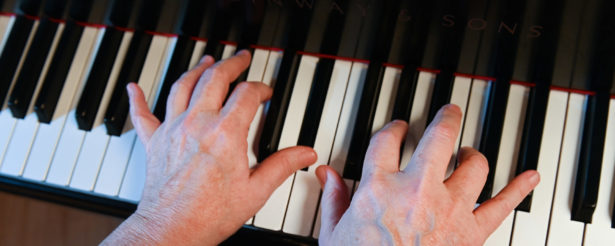Martha Summa- Chadwick calls it her “hair-on-the-back-of-the-neck moment.”
A pianist by profession and music therapist by passion, she was working with an autistic 4-year-old girl who had never spoken. The work was agonizingly slow at first.
After discovering that the girl was fascinated with computers, Summa-Chadwick—who has spent most of her paycheck-earning career as a computer specialist—turned to a software program with lessons on how to read music.
“It took a while but, when it took, it took off all of a sudden. She got it,” recalls Summa-Chadwick, who was teaching piano at UT Chattanooga at the time. “We plugged in the keyboard, and she started playing right away.
“And then she started singing.”
Such enormous breakthroughs are not the everyday results of music therapy. Mostly they’re incremental steps that lead to small successes that build upon each other. Since starting in the early 2000s, Summa-Chadwick has used music therapy to help those suffering not only from the mental and emotional effects of autism but also the physical effects of Parkinson’s disease, cerebral palsy and strokes.
It has not been an easy path to walk, she says. Not everyone— including some doctors—believes music therapy is beneficial or even works at all.
“Over 20 years of advocacy, there have been many times when I’ve said, ‘I’m done. I’m not doing this. I’m tired of getting doors slammed in my face. I’m tired of people walking away and saying, ‘No, this isn’t worth it.’ Then the next day I stand up and say, ‘It’s too important.’
“I truly, truly believe that music can revolutionize health care and education if we would only go there, and I have to carry that message.”
Neurological studies have shown that music therapy works, but the word isn’t getting out enough, she says.
“There’s gobs of neurosciences up there. It’s staying up there in neuroscience land. It’s not filtering down. That’s where the groundswell coming up from public opinion needs to happen.”
Jumpstarting public opinion is one of the biggest hurdles, though. They may hear the phrase, but most people often don’t know what music therapy actually is, says Summa-Chadwick, who earned a master’s degree in music in 1996 from UTC.
“The person on the street thinks that the musician playing over in the hospital is doing music therapy,” she says.
She’s doing her part to spread the word through such avenues as Ted Talks presentations, educational videos and published articles. She was chosen as a 2022 Honored Artist of the American Prize, a national nonprofit that describes itself as the nation’s most comprehensive series of contests in the classical arts. The Honored Arts award goes to individuals and ensembles that have shown outstanding creative or intellectual achievements. In Summa-Chadwick’s case, the award is for her advocacy of music as medicine.
Since 2013, she also has hosted the Power of Music concerts, annual performances that—along with a range of music that stretches across classical, jazz, blues, opera and pop, among others—feature panel discussions on the therapeutic outcomes of music therapy. The concerts are presented by Music Therapy Gateway in Communications, a nonprofit founded in 2013 by Summa-Chadwick, who remains its executive director.
Music therapy can work on multiple levels and improve multiple issues, she says, by increasing the brain’s plasticity, the condition of creating new neural pathways when others are damaged.
Walking, for instance, can be a serious issue for those with brain disfunction. Music can help alleviate some of those problems, Summa-Chadwick says.
The number of steps a person takes usually corresponds to the number of heartbeats per minute, she explains, so improvement means increasing or decreasing the music’s tempo to match the steps.
Brain damage caused by a stroke may mean a walking tempo of 60 beats per minute, almost slow motion. People with Parkinson’s take a lot of short steps to offset balance issues. Children on the autism spectrum walk in a “kinetic stutter,” she says.
“After a person has a stroke, you want to gradually bring them up so they’re walking faster. A person with Parkinson’s, who’s walking a lot, you want to slow that down, let them take longer steps. “
“With the children with autism, a lot of times the goal is just to get the gait stronger, specifically, walking on the beat.”
It may seem obvious, but a key factor in music therapy is finding the right type of music, whether it’s rock, jazz, classical, whatever, she says. For the best results, the music must have a personal relevance to the person. As an example, an older person with dementia may like the Beatles or Frank Sinatra, she says.
“Research shows that the music they’re going to prefer is what was happening in their formative years of high school or college,” she says.
On the other side of the age range, one of her young patients loved “Happy Birthday to You,” so she started therapy with it.
Things get tough if the patient is nonverbal.
“If they can’t communicate it, then it’s a best guess,” she says.
Sometimes those guesses don’t hit the right note.
“I remember there was a 5-year-old I was working with, and I thought every kid wanted ‘Wheels on the Bus,’ so I played ‘Wheels on the Bus.’
“He did really well for a while and then gradually he wasn’t doing as well. His mother said, ‘Would you play some Beethoven? He hates ‘Wheels on the Bus.’”


